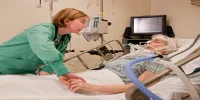Effective communication is vital in the intensive care unit (ICU). Communication in an ICU is usually thought to be most frequent between doctors and nurses. A study at the Loyola University Health System burn centre intensive care unit (ICU), however, showed that a dietitian, a social worker and three doctors a were the most central communicators of the patient clinical team. Patients were not included in the study.
David Shoham, PhD, associate professor in the Department of Public Health Sciences of Loyola University Chicago Stritch School of Medicine, and colleagues published their study in the American Burn Association's Journal of Burn Care & Research. Shoham explained that the pattern of who talks to whom dictates the centre or core of a communication system. "Being 'central' means these team members tie the team together and reduce the distance that information needs to travel between team members. This study showed we cannot presuppose doctors and nurses are the only important players healthcare settings."
The study, in a level 1 burn ICU, documented interactions with occupational therapists, respiratory therapists, medical students and housekeeping staff as well as care by physicians, nurses, social workers, dietitians and medical students. Clinical team members reported the frequency (0 to 3+ times) of discussion about patient care issues with every other coworker during a 24-hour period. The researchers then calculated the proportion of clinical team members completing the questionnaire, created a map (sociogram) of the network, identified central positions, and searched for weak points. A total of 69 coworkers were listed by 48 clinical team members (70% completion rate). There were 626 connections (arcs) present (density = 13.3%).
Shoham believes that comparing social network communication in patient health could lead to better patient outcomes. He emphasises that effective clinical care teams have high degrees of shared cognition. By contrast, those teams that work in silos are not as effective and present barriers to optimal patient care. The study will be used to guide subsequent data collection from this and other clinical teams to correlate team structural features with clinical process outcomes and patient safety. He is interested in conducting additional studies to compare communication networks in other intensive care units as well as non-intensive care units.
Source: ScienceDaily
Image source: freeimages.com
David Shoham, PhD, associate professor in the Department of Public Health Sciences of Loyola University Chicago Stritch School of Medicine, and colleagues published their study in the American Burn Association's Journal of Burn Care & Research. Shoham explained that the pattern of who talks to whom dictates the centre or core of a communication system. "Being 'central' means these team members tie the team together and reduce the distance that information needs to travel between team members. This study showed we cannot presuppose doctors and nurses are the only important players healthcare settings."
The study, in a level 1 burn ICU, documented interactions with occupational therapists, respiratory therapists, medical students and housekeeping staff as well as care by physicians, nurses, social workers, dietitians and medical students. Clinical team members reported the frequency (0 to 3+ times) of discussion about patient care issues with every other coworker during a 24-hour period. The researchers then calculated the proportion of clinical team members completing the questionnaire, created a map (sociogram) of the network, identified central positions, and searched for weak points. A total of 69 coworkers were listed by 48 clinical team members (70% completion rate). There were 626 connections (arcs) present (density = 13.3%).
Shoham believes that comparing social network communication in patient health could lead to better patient outcomes. He emphasises that effective clinical care teams have high degrees of shared cognition. By contrast, those teams that work in silos are not as effective and present barriers to optimal patient care. The study will be used to guide subsequent data collection from this and other clinical teams to correlate team structural features with clinical process outcomes and patient safety. He is interested in conducting additional studies to compare communication networks in other intensive care units as well as non-intensive care units.
Source: ScienceDaily
Image source: freeimages.com
References:
Shoham DA, Mundt MP, Gamelli RL, McGaghie WC (2014) The social network of a burn unit team. Journal of Burn Care & Research. doi: 10.1097/BCR.0000000000000218
Latest Articles
Communication, ICU, teams
Effective communication is vital in the intensive care unit (ICU). Communication in an ICU is usually thought to be most frequent between doctors and nurse...










